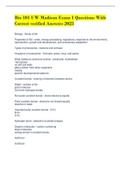Uw madison bio 101 - Study guides, Class notes & Summaries
Looking for the best study guides, study notes and summaries about Uw madison bio 101? On this page you'll find 26 study documents about Uw madison bio 101.
Page 3 out of 26 results
Sort by

-
UW Madison Bio 101 EXAM 4 latest solution update 2023.
- Exam (elaborations) • 5 pages • 2023
- Available in package deal
-
- $11.49
- + learn more
What is biological evolution? - Heritable change in a population across many generations. What is the difference between microevolution and macroevolution? - Microevolution is on a small scale. It is a change in a single gene. Macroevolution is on a large scale and results in the formation of a new species. What is a scientific theory (definition)? - A well-tested concept that explains a wide range of observations. What is catastrophism? - The idea presented by Georges Cuvier that major...
BUNDLED BIO 101- UW Madison Exams 2023

-
Package deal for Bio 101 Exam 1 Study Guide with Complete Solution 2023
- Package deal • 28 items • 2023
-
- $49.99
- + learn more
Bio 101 Exam 1 Study Guide with Complete Solution 2023 Biology 101 Exam 1 with 100% Correct Answers 2023 Biology 101 Exam 1 UNC with 100% Correct Answers 2023 BIO 101: EXAM 1 - Chapters 1, 44, 45, and 47 Question And Answers 2023 Bio 101 Exam 1 Review - Chapters 1-4 Question And Answers 2023 UW Madison Bio 101 Exam 1 with 100% Correct Answers 2023

-
BIO 101- UW Madison exam 4 VERIFIED CORRECT LATEST 2023 SOLUTION
- Exam (elaborations) • 22 pages • 2023
- Available in package deal
-
- $11.49
- + learn more
1. adaptation: inherited characteristics of organisms that enhance their survival and reproduction in specific environments 2. artificial selection: controlling survival and reproduction, dramatic change can occur in a short period of time 3. homology: similarity due to common ancestry 4. homologous structures: structures in different species that are similar be- cause of common ancestry 5. vestigial structures: components that serve no purpose, but are remanent from organisms ancestors 6. ...

-
BIO 101: EXAM BUNDLE 2024!!
- Package deal • 23 items • 2024
-
- $39.99
- + learn more
BIO 101: EXAM BUNDLE 2024!!BIO 101: EXAM BUNDLE 2024!!BIO 101: EXAM BUNDLE 2024!!BIO 101: EXAM BUNDLE 2024!!BIO 101: EXAM BUNDLE 2024!!BIO 101: EXAM BUNDLE 2024!!BIO 101: EXAM BUNDLE 2024!!BIO 101: EXAM BUNDLE 2024!!BIO 101: EXAM BUNDLE 2024!!BIO 101: EXAM BUNDLE 2024!!BIO 101: EXAM BUNDLE 2024!!BIO 101: EXAM BUNDLE 2024!!

-
Bio 101 UW Madison Exam 1 Questions With Correct verified Answers 2023
- Exam (elaborations) • 12 pages • 2023
- Available in package deal
-
- $11.49
- + learn more
Biology - Study of life Properties of life - order, energy processing, regulations, response to the environment, reproduction, growth and development, and evolutionary adaptation Types of prokaryotes - bacteria and archaea Kingdoms of eukaryotes - Animalia, protis, fungi, and plants What makes an animal an animal - eukaryote, multicellular has tissues no stiff cell walls gets nutrition from other organisms motility specific developmental patterns Covalent bonds - sharing of ...

Did you know that on average a seller on Stuvia earns $82 per month selling study resources? Hmm, hint, hint. Discover all about earning on Stuvia


